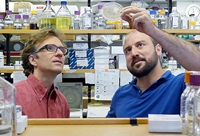Weapon-wielding marine microbes may protect populations from foes
By By Denise Brehm, Civil and Environmental Engineeri | 12 Sep 2012
Competition is a strong driving force of evolution for organisms of all sizes. Those individuals best equipped to obtain resources adapt and reproduce, while others may fall by the wayside. Many organisms - mammals, birds and insects, for instance - also form cooperative social structures that allow resources to be defended and shared within a population.
 |
| Professor Martin Polz, left, and postdoc Otto Cordero examine a petri dish of Vibrio bacteria. Photo: James M. Long, MIT |
But surprisingly, even microbes, which are thought to thrive only when able to win the battle for resources against those nearest to them, have a somewhat sophisticated social structure that relies on cooperation, according to MIT scientists. These researchers have recently found evidence that some ocean microbes wield chemical weapons that are harmless to close relatives within their own population, but deadly to outsiders.
The weapons are natural antibiotics produced by a few individuals whose closest relatives carry genes that make them resistant. The researchers believe that the few antibiotic producers are acting as protectors of the many, using the antibiotics to defend the population from competitors or to attack neighboring populations.
''We can't know what the environmental interactions really are, because microbes are too small for us to observe them in action,'' says Professor Martin Polz of MIT's Department of Civil and Environmental Engineering (CEE), lead investigator on a study appearing in the journal Science. ''But we think the antibiotics play a role in fending off competitors. Of course, those competitors could also produce antibiotics. It's a potential arms race out there.''
A population of ocean microbes is defined by genetic likeness and shared ecological activities, such as their preferred microhabitat - say, free-floating or attached to algae - or their ability to harvest a particular substance. Because close relatives within populations have very similar if not identical resource requirements, they must by necessity also be strong competitors with one another.
This makes cooperation involving antibiotics doubly surprising, because the ability to produce antibiotics is a classic example of a ''selfish'' gene that ought to increase the fitness - or reproductive rate - of the individual carrying the gene. In a strictly competitive environment, the microbe would use this advantage against its closest relatives. But now it looks as if this competition is modulated by social interactions where antibiotics produced by a few individuals act as ''public goods'': items that benefit the group, rather than just the individual.













.jpg)






.jpg)









